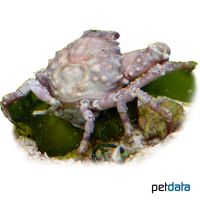Green Clinging Crab (Mithraculus sculptus)
| Green Clinging Crab Mithraculus sculptus | |
|---|---|
| Name | Green Clinging Crab |
| Name Lat. | Mithraculus sculptus |
| Family | Mithracidae |
| Family lat. | Mithracidae |
| Order | Decapoda |
| Order lat. | Decapoda |
| Origin | Western Atlantic |
| Diet | Omnivore |
| pH | 8.1-8.4 |
| Hardness | 6-10 °KH |
| Lighting | Low |
| Current | Moderate |
| Behavior | Semi-aggressive |
| Keeping | Individual, group |
| Care Level | Easy |
| Life Span | N/A |
| Protection | No |
| Metric Units | |
| Size | 3-4 cm |
| Temperature | 24-27 °C |
| Salinity | 33-36 ‰ |
| Aquarium | 50 l |
| US Units | |
| Size | 1.2"-1.6" |
| Temperature | 75-81 °F |
| Salinity | 1.020-1.025 sg |
| Aquarium | 15 gal |
Distribution and habitat
The distribution area of Mithraculus sculptus is the tropical West Atlantic, from the Bahamas through the Caribbean and the Gulf of Mexico to Brazil. They live on rocks and coral reefs, during the day mostly hidden in caves, crevices and under rocks
Maintenance
They need a well-structured aquarium with a reef structure (crevices, caves, shelters) and sandy areas, with live rocks that they can graze on (algae) and that act like a biological filter
Only substrates rich in lime and free of heavy metals may be used as substrate. Filters, skimmers and heaters are necessary to ensure water quality, as well as pumps to simulate tides, swells and bottom currents. Lighting must match the species-appropriate day-night rhythm of the animals
| Salinity: 33-36 ‰ | pH value: 8.1-8.4 |
| Carbonate hardness: 6-10 °KH | Nitrate content: 2-8 mg/l |
| calcium content: 400-450 mg/l | Nitrite content: 0.0-0.05 mg/l |
| Magnesium content: 1.250-1.350 mg/l | phosphate content: 0.01-0.1 mg/l |
Regular addition of trace elements, especially iodine, is recommended. For salinity, an average value should be aimed for, which may only vary slightly by +/- 0.5 ‰. Ammonia and ammonium must not be measurable. Special attention shall be paid to consistently good water quality and water values.
Diet
In nature they feed mainly on algae, algal growth and detritus. Special feeding is usually not necessary in a community tank, as they partake of the fish food (small mysis, krill, artemia, bosmids, dry food, etc.). If there is too little algae in the aquarium, dried nori algae leaves must be offered 1-2 times a week
Regular and varied feeding promotes health and increases resistance.
Behaviour and compatibility
They can be kept well in a group. Keeping several animals is only recommended in a larger, well-structured aquarium with sufficient food supply. A socialization with fish and invertebrates, by which they are not considered food, is very well possible.
Reproduction and breeding
The downward drawn abdomen (pleon) is flat and triangular in the male, broad and round in the female. They are free spawners. The eggs and larvae live planktonically and go through several stages of development until they become juvenile crabs. There are no known reports of successful breeding in the aquarium.
Important
If the water values are not appropriate (e.g. iodine content), moulting problems may occur.
They are well suited for algae control. With their spoon-like claw ends they graze the algae growth and eat red, brown and green algae (bubble algae).
If different species are kept together, care should be taken to match fish and invertebrates in terms of water quality and temperature requirements and social behavior, and to ensure that the setup meets the ecological needs of all species kept together. Newly introduced animals must be acclimated slowly to the water in the aquarium. Further literature can be found in your pet store.
References
Text: Werner Winter; Image: petdata
Source: KNOP (2013): Lexikon der Meeresaquaristik, Natur und Tier Verlag; ENGELMANN & LANGE (2011): Zootierhaltung - Tiere in menschlicher Obhut: Wirbellose, Verlag Harri Deutsch
